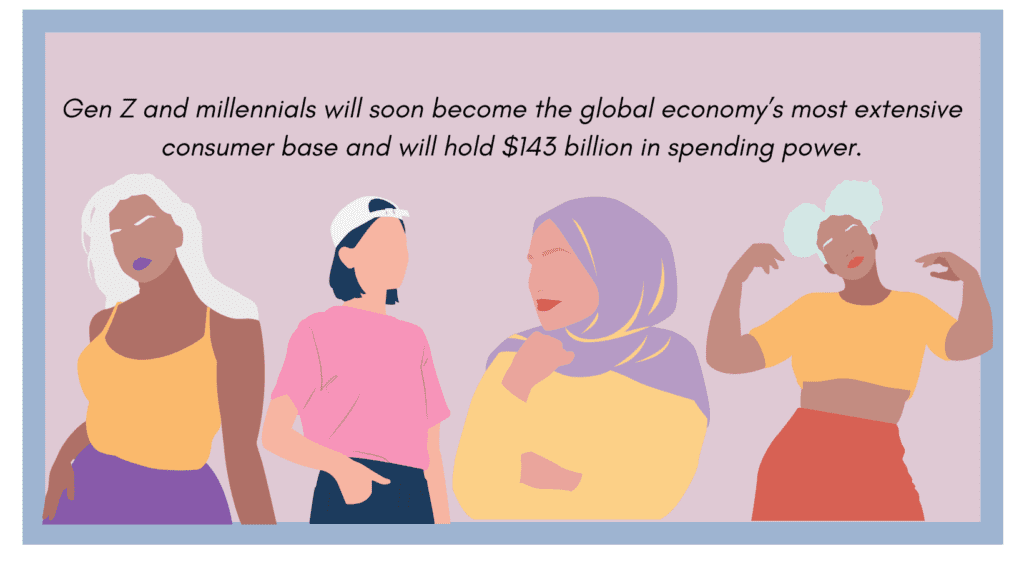Gen Zs have increasingly risen to question and seek alternatives from fashion retailers who lack sustainable goals. Young adults between 16-29 have increasingly adopted more conscious, sustainable shopping practices. Quick access to online information allows them to understand how their purchases affect the world around them. Research indicates that women under 35 who are aware and concerned about climate change run a higher risk of having eco-anxiety. Gen Zs have a greater sense of social responsibility compared to past generations, and morals and values shape their shopping habits. This model has pushed the emergence of alternative fashion businesses such as resale markets, vintage trends, and secondhand shops. Gen Zs are also now looking for fashion companies with corporate social responsibility policies and projects.
Gen Z and Fast Fashion
Fast fashion is the quick and cheap production of clothing, which is harmful to the environment and exploits garment workers. Gen Z consumers who are aware of the true cost of fast fashion and want to combat it, embrace more sustainable consumption behaviours. This is different for every youth because of their budget, sense of style, free time, self-image, cognitive dissonance and accessibility to alternatives. Social media also heavily influences them because their feeds are overwhelmed with influencers promoting new products, sponsored content, and quickly changing trends.
Gen Zs that experience eco-anxiety and believe they make a difference cope with their feelings through their actions. That can include buying from sustainable fashion brands, shopping secondhand or upcycling their clothing. However, the fashion industry makes a whopping $1.5 trillion every year through governmental policies, free trade practices, and supply chain management. However, Gen Zs believe that companies should take more responsibility to address the fashion industry’s social and environmental issues. The truth is, Gen Z and millennials will soon become the global economy’s most extensive consumer base and will hold $143 billion in spending power. Therefore, brands looking to capture the interest of rising consumers will need to address their sustainability demands.
Gen Z and Fashion Activism
Young consumers shopping in an eco-conscious manner are influenced by how they move between offline and online environments throughout the day. This generation primarily spends most of their money on clothes and shoes, and despite their concern for the impacts on people and the planet, a large base still buys from fast fashion brands. Research shows that Gen Zs care the most about sustainability and are buying more vintage pieces. They are also not afraid to demand change and pressure fashion brands to take on socially responsible commitments. This has created the emergence of greenwashing tactics that have created buzzwords like “eco-friendly” and “ethical,” yet businesses lack real programs and goals to prove these claims. This misleading marketing strategy has caused confusion and distrust in corporations.
Fashion activism has emerged to ensure that brands are honest and transparent about their business practices. Youth consumers are demanding sustainably sourced materials, recycling practices, and reuse manufacturing initiatives. But more and more young adults are turning to upcycled clothing, DIY fashion, online resale sites, and peer-to-peer marketplaces despite shopping fast fashion their whole life.
The Rise of Vintage
Gen Zs have turned to secondhand shopping because sustainable alternatives are often too expensive for their low budgets. However, 62 percent of Gen Zs would prefer to buy from sustainable brands, but only 54 percent would be willing to pay 10 percent or more for sustainable products. Gen Z’s sustainable shopping impact has undeniably pushed 50 fashion companies into the resale markets, including Burberry, Levi, Nordstrom, H&M, Canada and Boyish Jeans.
The demand for a better fashion industry has also created tangible and positive changes in policy work. The International Accord for Health and Safety in the Textile and Garment Industry was effectively passed to replace the Bangladesh Accord on Fire Building Safety. In September 2021, it will provide safety coverage to more than 2 million Bangladeshi garment workers. This was made possible by the solidarity and efforts shown by fashion activists, consumers, unions, and organizations working together to improve the fashion industry.
Take Action
Gen Zs are on the rise to reshift the fashion industry and demand the changes they want to see. Take part in the change by joining the Fashion Takes Action Youth Ambassador program. You will become part of a team of passionate youth found across the globe spreading awareness around sustainable fashion. In addition, you can get access to insightful virtual events, contribute to FTA’s newsletter, blog, and volunteer for amazing causes!

